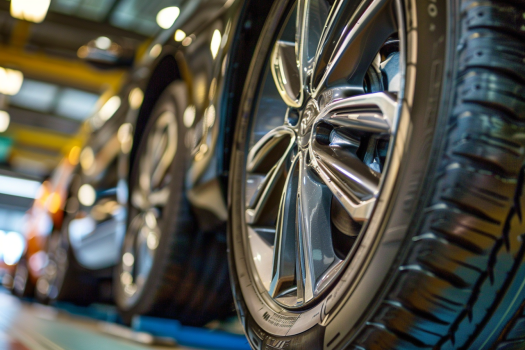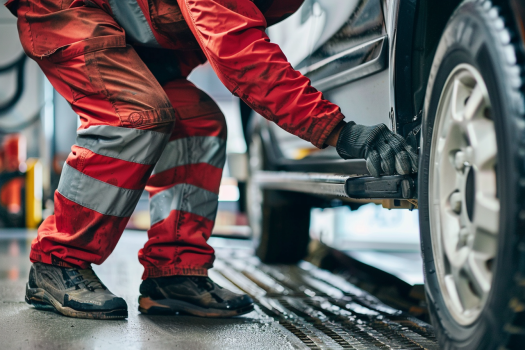Last Updated on March 27, 2025
Understanding the Tires So Expensive
Tires are often disregarded despite being one of the most critical components of any vehicle. They are your car’s primary point of contact with the road, and their condition directly impacts your safety, comfort, and performance. People often ask why tires are so expensive. In this post, we will look at the numerous elements that affect tire prices, highlighting why they cost what they do.

Understanding the Importance of Tires So Expensive
Tires, the often-overlooked heroes of our vehicles, are vital to our road safety and driving enjoyment. In this section, we’ll look at the importance of tires beyond their physical existence, including how they affect our safety, performance, and overall driving happiness.
Safety on the Road
Safety is one of the most critical factors influencing tire pricing. Tires play an essential role in your safety when driving. They provide the required grip and traction to stabilize your car, especially in harsh conditions like rain or snow. High-quality tires with advanced tread patterns and compounds are designed to minimize the risk of accidents by offering superior control and braking capabilities. Subsequently, investing in safer tires directly invests in your well-being and that of your passengers.
Performance and Handling
Beyond safety, tires considerably impact your vehicle’s performance and handling. Different tire kinds are available to meet various driving needs, including all-season, summer, winter, and performance tires. Performance tires, for example, improve your vehicle’s handling, allowing for enhanced cornering and control at high speeds. The engineering that goes into these specialized tires increases the production cost, which is reflected in the pricing.
Durability and Longevity
Tire manufacturers invest in research and development to provide long-lasting goods. The purpose is to ensure that tires have a respectable lifespan, lowering the number of replacements. Longer-lasting tires save you money and help the environment by minimizing tire trash. High-quality materials and creative production procedures are frequently used to provide durability, which might raise costs.
The Perplexing Price Tag
Have you ever wondered why tires have such a high price tag? In this section, we will investigate the riddle of tire price. We’ll look at the numerous elements influencing tire prices, shedding light on the intricacies confusing many buyers.
Material Costs
Tires are complex structures of various materials, including rubber compounds, steel belts, and fabric. The quality and type of these materials can significantly impact tire performance and longevity. High-performance tires, for instance, may incorporate advanced rubber compounds that enhance grip but also come at a higher cost. Steel reinforcement provides strength but adds weight, affecting fuel efficiency. Understanding the trade-offs in materials helps explain the price variations among different tire models.
Advanced Technology
Modern tires incorporate cutting-edge technology to meet the demands of today’s vehicles. Innovations like run-flat technology, which allows a tire to maintain functionality even after a puncture, are examples of tire costs that add to tire costs. Additionally, some tires come equipped with real-time sensors to monitor tire pressure and temperature, enhancing safety and performance but increasing the overall price.
Manufacturing Precision
Tire manufacturing requires precision and quality control. The process involves curing rubber, ensuring proper balance, and inspecting for defects. High consistency and high production standards add to the cost. Furthermore, specialized manufacturing techniques are needed for specific tire types, such as low-profile tires for sports cars or studded winter tires for icy conditions.
The high price tag of tires is not merely arbitrary; it reflects the intricate engineering, advanced materials, safety considerations, and performance enhancements that go into their production. Understanding these factors helps us appreciate the value of investing in quality tires, as they directly impact our safety, comfort, and driving experience. So, the next time you wonder why tires cost so much, remember that you are paying for more than just rubber and air; you are investing in your safety and your vehicle’s performance.
Quality Matters
When it comes to tires, quality is paramount. The quality of your tires can significantly affect your safety, performance, and overall driving experience. In this section, we’ll explore why quality matters when choosing the right tires for your vehicle.
The Relationship Between Tire Quality and Price
Quality should be a top consideration for any vehicle owner when purchasing tires. The complex relationship between tire quality and price significantly ensures your safety, performance, and overall driving experience. Let’s explore this relationship in detail.
Tire Quality and Safety
One of the primary reasons quality matters when it comes to tires is safety. High-quality tires are engineered to provide optimal grip and traction on various road surfaces, including wet, dry, and icy conditions. They have superior braking capabilities, allowing you to stop your vehicle quickly in emergencies. This enhanced safety feature can be a lifesaver, making quality tires a worthwhile investment.
Performance Enhancements
Quality tires are designed to enhance your vehicle’s performance. They contribute to better handling, improved cornering stability, and a smoother ride. These performance enhancements are especially noticeable with premium and performance-oriented tires. If you value a comfortable and responsive driving experience, opting for higher-quality tires is necessary.
Durability and Longevity
Quality tires are built to last. They are constructed with durable materials and advanced manufacturing processes that increase lifespan. This means you’ll have to replace them less frequently, ultimately saving you money in the long run. Furthermore, the longevity of high-quality tires reduces environmental waste, making them an environmentally responsible choice.
Noise and Comfort
Lower-quality tires are often associated with increased road noise and a less comfortable ride. Premium tires, on the other hand, are designed to minimize road noise and provide a smoother, quieter driving experience. Investing in quality tires can significantly improve your overall driving satisfaction by prioritizing comfort during your journeys.
Why Premium Tires Cost More
Now that we understand the importance of tire quality, we must address why premium tires have a higher price tag. Although the cost of premium tires can be puzzling, several factors contribute to their higher price and make them worth the investment.
Advanced Materials
Premium tires are made with advanced materials, including specialized rubber formulations that provide excellent grip and performance. These materials are more expensive to buy and manufacture, increasing prices. Furthermore, employing high-quality materials increases the tire’s resilience to wear and tear.
Research And Development
Tire manufacturers invest considerable research and development to generate premium tire types. This comprises rigorous testing, computer simulations, and real-world evaluations to verify that these tires meet the highest safety and performance criteria. These R&D activities involve significant expenses, which are reflected in the price of premium tires.
Innovative Technology
Premium tires often feature innovative technologies that further enhance their performance. These can include run-flat technology, which allows a tire to continue functioning even after a puncture, or integrated sensors that monitor tire pressure and temperature in real-time. These technological advancements not only improve safety but also add to the overall cost of production.
Quality Control
Quality control is critical when creating premium tires. Each tire is thoroughly inspected and tested to meet strict quality standards. This careful quality control method increases production costs while ensuring that each contributed premium tire satisfies the highest quality and performance standards.
The relationship between tire quality and price is evident in the many benefits of high-quality tires. They provide safety, performance, durability, and comfort that justify their higher cost. P premium tires, in particular, stand out for using modern materials, considerable research and development, new technology, and rigorous quality control. While premium tires may require a higher initial cost, the long-term benefits of safety, performance, and longevity make them an excellent choice for any smart car owner.
Material Matters
Tires are more than meets the eye; they are complex assemblies of various materials, each playing a crucial role in their performance and longevity. This section will delve into the world of tire materials and their impact on tire costs and performance.
Exploring the Role of Materials in Tirleadosts
Tires are more than rubber and air; they are complex engineering marvels of various materials that influence their performance, longevity, and price. In this section, we will delve into the critical role of materials in tire cost.
The Rubber Compound
The primary material in tires is rubber, yet not all rubber is the same. High-quality tires are made with precisely developed rubber compositions that give excellent grip, tread life, and wear resistance. These compounds are designed to work well in various weather conditions, including blistering summer heat, pouring rain, and icy winter roads. Developing and using these advanced rubber compounds increases the cost of high-quality tires.
Reinforcing Materials
Tires also incorporate various reinforcing materials to provide strength and stability. These materials include steel belts and fabric plies. The number of layers and the type of reinforcement used can vary depending on the tire’s intended purpose. Performance and premium tires often have multiple steel belts for added rigidity, which can improve handling but also increase production costs.
Tread Patterns
The tread pattern on a tire is not merely a cosmetic design; it serves a functional purpose. The tread pattern affects traction, handling, and water removal. High-quality tires have exactly built tread patterns that maximize performance. These designs are generated using precise molding and cutting procedures, which add complexity to the manufacturing process and increase costs.

The Impact of Advanced Tire Technology
Now that we’ve explored the role of materials in tire costs, it’s essential to understand how advanced tire technology further affects tire performance and price.
Run-Flat Technology
Run-flat technology is a game-changer in the tire industry. It allows a tire to continue functioning even after it has been punctured, providing drivers with extended mobility to reach a safe location for repair or replacement. However, implementing run-flat technology involves intricate engineering, including reinforced sidewalls and heat-resistant compounds. While this technology enhances safety, it also contributes to the overall cost of tires.
Low Rolling Resistance
With a growing focus on fuel efficiency and environmental sustainability, tire manufacturers have developed tires with low rolling resistance. These tires reduce the energy required to roll, improving fuel economy. Achieving low rolling resistance often involves using specialized materials and tread designs, adding to the cost of production. However, the long-term fuel savings can offset this initial expense.
Sensors and Monitoring Systems
Some modern tires have built-in sensors that monitor tire pressure and temperature in real time. These systems provide critical data to drivers, enhancing safety and performance. Integrating sensors into tires requires additional technology, design, and manufacturing complexity, contributing to cost.
The materials used in tire construction and advanced tire technology are essential factors that influence tire costs. Q quality tires employ specialized rubber compounds, reinforcing materials, and precise tread patterns to optimize performance and safety. Advanced technology such as run-flat capabilities, low rolling resistance, and tire monitoring systems add to the cost but offer valuable benefits. Considering the price of tires, it’s essential to recognize that these materials and technologies are investments in safety, durability, and overall driving satisfaction.
Safety and Performance
Safety and performance are at the core of every tire’s purpose. In this section, we’ll examine how tires play a crucial role in ensuring your safety on the road and how their performance characteristics can transform your driving experience. Understanding these aspects is essential for making informed tire choices.
How Tires Influence Safety on the Road
Regarding road safety, one component of your vehicle stands out as a critical factor: your tires. In this section, we’ll explore how tires play a pivotal role in ensuring safety on the road and why choosing the right tires is a decision that should never be taken lightly.
Traction and Grip
Tires are your vehicle’s only point of contact with the road surface, so their level of traction is essential for safety. High-quality tires use specialized rubber formulations and tread patterns to maximize traction. This implies they can maintain traction in unfavorable conditions like wet roads, slick surfaces, or abrupt brakes. Quality tires considerably reduce the chance of skidding or sliding, allowing you to keep control of your car, particularly in an emergency.
Wet and Dry Performance
Wet and dry performance is essential to tire safety. Tires intended for wet performance contain channels and grooves that efficiently channel water away from the contact patch, thereby preventing hydroplaning. On the other hand, dry performance ensures stability in everyday driving situations. Premium tires excel in wet and dry performance, giving you the confidence to drive safely in all weather conditions.
Braking Distance
Proper braking distance can save lives. T res affects braking distance, and high-quality tires are designed to lessen it. When you press the brakes, quality tires grip the road surface well, resulting in shorter stopping distances. This feature is especially useful in crises where every inch counts.
Cornering and Handling
Tire quality directly affects your vehicle’s cornering and handling capabilities. Premium tires offer superior cornering stability and responsive handling, enhancing safety and making your driving experience more enjoyable. They also provide the necessary grip to navigate sharp turns, confidently reducing the risk of accidents.
Performance Enhancements and Their Costs
As we have seen, tire safety is a primary focus. However, tires are essential in improving your car’s overall performance. In this section, we will look at how performance-enhancing features affect tire costs.
Performance-Oriented Tread Patterns
Performance tires frequently have aggressive tread patterns designed for maximum grip and handling. These patterns have been carefully constructed to ensure maximum contact with the road, resulting in improved acceleration, cornering, and braking. However, the complexity of these tread designs and the precision necessary to manufacture them raises the cost of production.
Speed Ratings
Tires are assigned speed ratings that show their maximum safe speed capability. Performance tires typically have higher speed ratings, allowing for more incredible speeds without compromising safety. However, achieving these high-speed capabilities requires using modern materials and production procedures, which raises the cost of performance tires.
Low-profile tires
Low-profile tires have shorter sidewalls and broader rims. They are commonly used in sports cars to improve handling and appearance. However, they are more challenging to manufacture and require specialized materials to retain strength and stability, which results in a higher price tag than regular tires.
Noise-Reduction Technology
Many premium tires include technology to reduce road noise, resulting in a quieter and more comfortable driving experience. These noise-reduction measures, such as optimized tread patterns and noise-canceling materials, increase the overall cost of the tire while significantly improving driving comfort.
The safety and performance of your vehicle are intimately linked to the quality and type of tires you choose. T res influences safety by increasing traction, reducing braking distances, and improving cornering stability. P premium tires excel in these areas, making them a good choice for your safety. Furthermore, while increasing the cost, performance-enhancing features provide benefits such as improved handling, speed capabilities, and driving comfort, giving them an option for individuals who value performance. Regarding tires, achieving the correct balance between safety and performance is essential for a safe and enjoyable driving experience.
Economics of Tire Production
The tire industry is a complex sector affected by various economic factors. In this section, we’ll delve into the economics behind tire production, exploring the factors that impact manufacturing costs and ultimately affect the price you pay for your tires.
Raw Materials
One of the most critical factors affecting tire manufacturing costs is the price of raw materials. Tires are made from various materials, including natural and synthetic rubber, steel, fabric, and chemical additives. The cost and availability of these materials can fluctuate due to factors such as global supply chains, natural disasters, and market demand. For example, changes in the price of rubber can directly impact tire production costs.
Manufacturing Techniques
The processes used in tire manufacture might vary greatly, affecting production costs. Some tire types require specialized manufacturing techniques, such as low-profile performance tires or massive off-road tires. These procedures might be more labor-intensive, time-consuming, and technologically advanced, increasing manufacturing costs. Furthermore, the precision necessary for tire production complicates and increases the price of the process.
Research and Development
Tire manufacturers invest majorly in research and development (R&D) to innovate and improve tire performance, safety, and durability. While R&D efforts result in superior tire technology, they also incur significant costs. Testing, engineering, and validation of new tire compounds, tread designs, and technologies require substantial testing, all of which increase the overall cost of tire production.
Quality Control
Quality control is an essential part of tire manufacturing. Extensive inspections and testing ensure that each tire fulfills tight quality standards. A deviation from quality standards may result in faults and safety hazards. Maintaining a high degree of quality control raises manufacturing costs by requiring qualified workers, testing equipment, and time.
Supply and Demand Dynamics
Beyond the manufacturing process, supply and demand factors in the tire sector impact tire production economics.
Seasonal demand
Tire demand varies seasonally, with winter tires in higher demand in the colder months and summer tires in the warmer months. Manufacturers must change production schedules to accommodate seasonal demand changes. Creased manufacturing capacity or inventory management might impact total costs.
Economies of Scale
Large tire manufacturers profit from economies of scale. Producing tires in large quantities allows them to distribute fixed costs, such as machinery and labor, over larger units, leading to a lower per-unit production cost. Smaller producers may experience more significant manufacturing costs because they cannot achieve the same economies of scale.
Competition
among tire manufacturers can also influence pricing and production costs. Tense competition may lead to price wars, forcing manufacturers to reduce prices to remain competitive.
Conversely, when demand outpaces supply, manufacturers may have more pricing power, allowing them to maintain or increase prices to improve profitability.
Global Market Trends
Global market trends, such as shifting customer tastes and regulatory changes, can impact tire production costs. For example, rising demand for environmentally friendly tires with low rolling resistance has resulted in the development of novel tire technology. However, these technologies may have a more significant production cost. Furthermore, changing tire labels and safety standards rules might force manufacturers to make costly changes to their manufacturing methods.
Environmental Considerations
In an increasingly environmentally conscious society, the tire sector faces significant challenges concerning its environmental impact. This section will examine the ecological implications of tire production and usage. We’ll discuss everything from the eco-friendly tire conundrum to the problematic balance between cost and sustainability.
Eco-Friendly tire Dilemma
In an era of growing environmental consciousness, the tire industry faces a unique challenge: balancing the demand for sustainable, eco-friendly tires with practical and economic concerns in tire manufacture. In this section, we will look at the complicated eco-friendly tire challenge.
Sustainable Materials
Eco-friendly tires aim to reduce their environmental footprint using sustainable materials. This includes incorporating natural rubber from responsibly managed sources and replacing traditional oil-based materials with renewable alternatives. While these materials contribute to sustainability, they may come at a higher cost, posing a challenge in striking the right balance between sustainability and affordability.
Low Rolling Resistance
Reducing rolling resistance is an essential aspect of eco-friendly tire design. Tires with low rolling resistance demand less moving energy, which leads to increased fuel efficiency and lower carbon emissions. However, achieving low rolling resistance frequently requires specialized rubber compounds and complex tread designs, which can raise production costs.
Noise Reduction
Eco-friendly tires are also engineered to be quieter, leading to a more enjoyable driving experience and less noise pollution. These tires use noise-reducing technology, such as optimized tread designs and materials.
While this technology improves sustainability and comfort, it can raise the overall cost of production.
Tire Longevity
Sustainability goes beyond the materials used in tire manufacturing. Eco-friendly tires are designed for durability, which means they last longer and require fewer repairs. While this is environmentally responsible, it can be challenging to balance making long-lasting tires and the commercial interests of manufacturers, who benefit from increased tire sales.
Balancing cost and sustainability
As customers value environmental sustainability more, tire producers require assistance balancing sustainability and production costs.
Research and Development.
Creating eco-friendly tire technology requires significant research and development. Re-manufacturers invest in research and development to produce tires that meet or exceed environmental criteria while retaining performance. These initiatives can lead to innovations like bio-based materials and better tire designs, but they also have substantial prices that may affect tire pricing.
Market Demand
The market demand for environmentally friendly tires may affect their price. As consumer knowledge and interest in sustainability grow, so does the need for environmentally friendly tires. To accommodate this need, manufacturers may engage in sustainable tire production; nevertheless, early investments may impact tire pricing.
Regulatory Compliance
Environmental regulations and standards are essential to making tires environmentally friendly. Manufacturers must follow these laws governing tire production procedures and material changes. While these improvements help to promote sustainability, they can also increase production costs, which may be passed on to customers.
Affordability and Accessibility: One key challenge in balancing cost and sustainability is making eco-friendly tires affordable and accessible to many consumers. Striking the right price point is essential to encourage more drivers to choose environmentally responsible tires. Manufacturers are exploring ways to achieve this balance, such as optimizing production processes and sourcing sustainable materials cost-effectively.
Tire Maintenance
Proper tire maintenance is the beginning of safe and cost-efficient driving. In this section, we’ll explore the essential aspects of tire maintenance, including strategies to extend the lifespan of your tires and cost-effective tips to keep them in proper condition. Proper tire care enhances your safety on the road and helps you maximize the value of your tire investment.
Extending the Lifespan of Your Tires
Your tires are critical to your vehicle, and proper maintenance ensures longevity. In this section, we’ll explore practical strategies for extending the lifespan of your tires, which can lead to cost savings and improved safety.
Proper Inflation
The most important aspect of tire maintenance is maintaining the correct tire pressure. Underinflated tires can lead to increased wear, reduced fuel efficiency, and decreased handling performance. Overinflated tires can result in a harsher ride and uneven wear. Regularly check your tire pressure using a reliable gauge and keep it at the recommended level specified in your vehicle’s manual.
Regular Rotation
Tire rotation involves moving tires to different positions on your vehicle to ensure even wear. Front and rear tires experience different loads and wear patterns, so rotating them regularly can help distribute wear more evenly. This extends tire life and ensures you get the most mileage out of each set of tires.
Wheel Alignment
Proper wheel alignment ensures your tires face the correct direction, reducing uneven wear. M-aligned wheels can cause excessive tire wear and poor handling performance. If your vehicle is dragging to one side or experiencing steering vibrations, your wheel alignment should be examined and changed as necessary.
Balance Your tires
Wheel balancing ensures that the tire’s weight and the wheel assembly are evenly distributed. Unbalanced tires can cause uneven wear and steering problems. Regular tire balancing provides a smooth and comfortable ride while extending tire life.
Inspect for Damage
Regularly inspect your tires for signs of damage, such as punctures, cuts, or bulges. If you discover any of these problems, have them repaired or replaced immediately. Diving with faulty tires can cause severe blowouts and damage to your car.
Cost-Effective Tire Maintenance Tips
Tire care is essential, but it does not have to be expensive. Here are some cost-effective tire care tips to help you save money while keeping your tires in good condition.

DIY Tire Maintenance
Many aspects of tire maintenance, such as checking tire pressure, can be quickly done at home with minimal cost. I vesting in a reliable tire pressure gauge and learning to perform basic maintenance tasks can save you money on professional service fees.
Maintain Proper Tire Storage
Proper storage is essential if you have seasonal tires. Sore your unused tires in a cool, dry place away from direct sunlight. Using tire storage bags or racks can help protect them from damage. Proper storage ensures that your tires remain in good condition and don’t deteriorate prematurely.
Choose Fuel-Efficient Tires
When it’s time to replace your tires, consider fuel-efficient options. These tires are designed to reduce rolling resistance, improving fuel efficiency. While they may have a slightly higher upfront cost, the long-term savings on fuel expenses can outweigh the initial investment.
Drive Responsibly
Your driving style has a significant impact on tire wear. Old aggressive driving, quick stops, and fast corners, as they might increase tire wear. Smooth and cautious driving enhances tire life and helps improve fuel economy.
Tire maintenance is an essential component of car ownership that must be considered. Proper maintenance procedures, such as maintaining tire pressure, rotating, aligning, and balancing, can significantly extend the life of your tires, saving you money in the long term. Furthermore, cost-effective tire care advice, such as DIY maintenance and fuel-efficient tire selection, can help you attain peak tire performance while staying within your budget. I vesting time and effort in tire care benefits your safety and budget.
Conclusion & Recommendation
As we wrap up our exploration of the tire price mystery, this section summarizes significant insights and provides actionable recommendations. D discover the key takeaways from our tire journey and find expert recommendations for making informed choices regarding your vehicle’s tires.
Summing Up the Tire Price Mystery
Throughout this comprehensive guide, we’ve delved into the intricate world of tires, exploring the factors that contribute to their prices, the importance of quality and materials, the role of sustainability, and the significance of maintenance. As we conclude, let’s summarize the key takeaways from our tire price explanation.
- Quality Matters: We’ve learned that tire quality plays a pivotal role in safety, performance, and longevity. Vesting in high-quality tires is a smart choice for any vehicle owner.
- Materials Make a Difference: The materials used in tire construction, from specialized rubber compounds to reinforcing materials, significantly impact tire performance and cost.
- Advanced Technology Matters: Advanced tire technology, such as run-flat capabilities, low rolling resistance, and monitoring systems, enhances safety and performance but can increase costs.
- Economics at Play: Tire production costs are affected by factors like raw materials, manufacturing techniques, R&D, quality control, and supply and demand dynamics.
- Environmental Considerations: Sustainability is an emerging concern, with eco-friendly tires offering benefits for both the environment and long-term cost savings.
- Tire Maintenance: Proper tire maintenance, including inflation, rotation, alignment, balancing, and regular inspections, can extend tire lifespan and save money.
Making Informed Choices
Armed with our knowledge, it’s time to make informed choices regarding your tires. Here are some actionable recommendations:
- Prioritize Quality: When buying tires, prioritize quality over price. Q quality tires offer better safety, performance, and durability.
- Consider Your Needs: Choose tires based on your specific driving needs. C consider factors like climate, road conditions, and vehicle type.
- Explore Eco-Friendly Options: If sustainability is important, explore eco-friendly tire options that balance environmental responsibility with performance.
- Invest in Maintenance: Regular tire maintenance is essential. T extends tire life and commits to proper inflation, rotation, alignment, and inspections.
- Research and Compare: Research tire options and compare prices and reviews before purchasing. Based on your findings, make an informed decision.
- Consider visiting Tires-Easy, a trusted online tire retailer, to find a wide selection of high-quality tires. Their user-friendly website makes it easy to browse and purchase the right tires for your vehicle.
Ready to Buy Tires?
Now that you’re armed with knowledge about tire quality, materials, technology, economics, sustainability, and maintenance, it’s time to take action. Click the button below to explore a wide range of quality tires on the Tires-Easy website. Make an informed choice today and ensure your vehicle’s tires’ safety, performance, and longevity.
Remember, your tires are a vital component of your car, and your choices now can impact your safety, driving experience, and long-term savings. Make the right choice by choosing quality tires that match your needs and maintaining them regularly. Safe travels!
FAQs:
Why are my tires so expensive?
Tires can be costly due to quality, materials, and advanced technology. I vesting in high-quality tires ensures safety and performance.
Is it better to get cheap or expensive tires?
While cheap tires may save money upfront, expensive tires offer better protection, longevity, and performance, making them a wiser long-term investment.
Why not buy the cheapest tires?
The cheapest tires may compromise safety and performance. I vest more in quality tires to ensure better handling and durability on the road.
How expensive is a good tire?
Good tires can vary in price, but quality comes at a cost. Prices depend on factors like size, brand, and type, but the value they provide is worth it.
Which tire brand is the most expensive?
High-end brands like Michelin, Pirelli, and Bridgestone are among the most expensive due to their advanced technology and performance capabilities.
How costly are tires?
Depending on size, brand, and specific features, expensive tires can range from $100 to $300 or more per tire.
Why are Bridgestone tires costly?
Bridgestone tires often feature advanced technology and premium materials, which contribute to their cost. However, they are known for their quality and performance.
Which tire brand is good?
Several tire brands offer quality options. Popular choices include Michelin, Goodyear, Continental, and Bridgestone, which are known for their reliability and performance.
-
Writer











 English
English Français
Français Español
Español